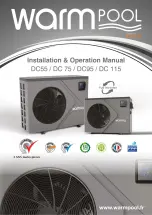
7
•
Frequent washing of the cabinet, fan blade and coil with fresh water will remove
most of the salt or other contaminants that build up on the unit.
•
Regular cleaning and waxing of the cabinet with an automobile polish will pro-
vide some protection.
•
A liquid cleaner may be used several times a year to remove matter that will not
wash off with water.
Several different types of protective coatings are offered in some areas. These
coatings may provide some benefit, but the effectiveness of such coating materials
cannot be verified by the equipment manufacturer.
3.2 CONDENSER LOCATION
Consult local and national building codes and ordinances for special installation
requirements. Following location information will provide longer life and simplified
servicing of the outdoor condenser.
NOTE:
These units must be installed outdoors. No ductwork can be attached, or
other modifications made, to the discharge grille. Modifications will affect perfor-
mance or operation.
3.3 OPERATIONAL ISSUES
•
IMPORTANT:
Locate the condenser in a manner that will not prevent, impair or
compromise the performance of other equipment horizontally installed in prox-
imity to the unit. Maintain all required minimum distances to gas and electric
meters, dryer vents, exhaust and inlet openings. In the absence of National
Codes, or manaufacturers’ recommendations, local code recommendations
and requirements will take presidence.
•
Refrigerant piping and wiring should be properly sized and kept as short as
possible to avoid capacity losses and increased operating costs.
•
Locate the condenser where water run off will not create a problem with the
equipment. Position the unit away from the drip edge of the roof whenever pos-
sible. Units are weatherized, but can be affected by water pouring into the unit
from the junction of rooflines, without protective guttering.
3.4 FOR CONDENSERS WITH SPACE LIMITATIONS
In the event that a space limitation exists, we will permit the following clearances:
Single Unit Applications:
One condenser inlet air grille side may be reduced to no
less than a 6-inch clearance. Clearances below 6 inches will reduce unit capacity
and efficiency. Do not reduce the 60-inch discharge, or the 24-inch service clear-
ances.
Multiple Unit Applications:
When multiple condenser grille sides are aligned, a 6-
inch per unit clearance is recommended, for a total of 12 inches between two units.
Two combined clearances below 12 inches will reduce capacity and efficiency. Do
not reduce the 60-inch discharge, or 24-inch service, clearances.
3.5 CUSTOMER SATISFACTION ISSUES
•
The condenser should be located away from the living, sleeping and recreation-
al spaces of the owner and those spaces on adjoining property.
•
To prevent noise transmission, the mounting pad for the outdoor unit should
not be connected to the structure, and should be located sufficient distance
above grade to prevent ground water from entering the unit.
3.6 PROPER INSTALLATION
Proper sizing and installation of equipment is critical to achieve optimal perfor-
mance. Use the information in this Installation Instruction Manual and reference the
applicable Engineering Specification Sheet when installing this product.
IMPORTANT:
This product has been designed and manufactured to meet ENER-
GY STAR
®
criteria for energy efficiency when matched with appropriate coil compo-
nents. However, proper refrigerant charge and proper air flow are critical to achieve
rated capacity and efficiency. Installation of this product should follow the manufac-
turer’s refrigerant charging and air flow instructions.
Failure to confirm proper
charge and airflow may reduce energy efficiency and shorten equipment life.
!
WARNING
DISCONNECT
ALL
POWER
TO
UNIT
BEFORE
STARTING
MAINTENANCE. FAILURE TO DO SO CAN CAUSE ELECTRICAL SHOCK
RESULTING IN SEVERE PERSONAL INJURY OR DEATH.








































